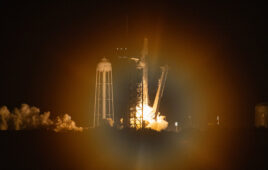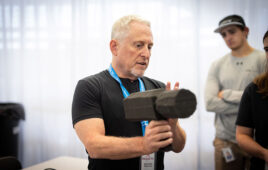
A new design may allow robotic spacecrafts to travel longer distances into space, possibly leading to a voyage to Mars.
Researchers from the Harbin Institute of Technology in China have created a new inlet design for Cylindrical shaped Hall thrusters (CHTs) that may significantly increase the thrust and allows spaceships to travel greater distances.
Xenon is often used as a propellant for Hall Thrusters. This is accelerated by an electric field which strips electrons from neutral xenon atoms, creating a plasma. Plasma ejected from the exhaust end of the thruster can deliver great speeds, typically around 70,000 mph.
CHTs are designed for low-power operations while low propellant flow density can cause inadequate ionization—a crucial step in the creation of the plasma and the generation of thrust. A thruster’s performance improves by increasing the gas density in the discharge channel, while lowering its axial velocity—the speed perpendicular to the thrust direction.
“The most practical way to alter the neutral flow dynamics in the discharge channel is by changing the gas injection method or the geometric morphology of the discharge channel,” Liqiu Wei, a lead author on the paper, said in a statement.
The researchers injected the propellant into the cylindrical chamber of the thruster by a number of nozzles that usually point straight in, toward the center of the cylinder. The angle of the inlet nozzles changed slightly, sending the propellant into a rapid circular motion and creating a vortex in the channel.
They then simulated the motion of the plasma in the channel for both nozzle angles using modeling and analysis software called COMSOL that uses a finite element approach to modeling molecular flow.
This resulted in a gas density near the periphery of the channel is higher when the nozzles are tilted and the thruster is run in vortex mode.
According to the study, the vortex inlet increases the propellant utilization of the thruster by 3.12 percent to 8.81 percent, thrust by 1.1 percent to 53.5 percent, specific impulse by 1.1 percent to 53.5 percent, thrust-to-power ratio by 10 percent to 63 percent and anode efficiency by 1.6 percent to 7.3 percent, greatly improving the thruster performance.
“The work we report here only verified the practicability of this gas inlet design,” Wei said. “We still need to study the effect of nozzle angle, diameter, the ratio of depth to diameter and the length of the discharge channel.”
According to Wei, the vortex design will be tested in flight-type HTs in the near future and could potentially be used in spaceflights.
The study was published in the Physics of Plasmas.




